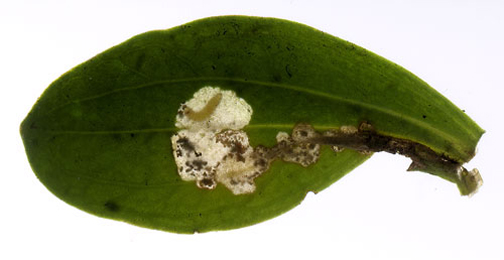|
||||||
|
Stenoptilia
zophodactylus (Duponchel, 1840) Dowdy Plume Pterophorus
zophodactylus
Duponchel, 1840. Hist. nat. Lep.
Fr. 11: 668, t. 314 fig. 4. |
|||||||||||||||||||||||||||||||||||||||||||||||||||||||||||||||||||||||||||||||||
Leaf-miner: Initially the larva mines a basal leaf, subsequently feeding in flower buds (which turn yellow), opened flowers and foliage (UKMoths). Full depth irregular blotch that may occupy an entire leaf. Frass in numerous, dispersed, brown grains. Some larvae remain in the mine until shortly before pupation, others leave the mine in an early stage and feed externally on the flower buds and developing fruits (Bladmineerders van Europa).
Larva: The larvae of moths have a head capsule and chewing mouthparts with opposable mandibles (see video of a gracillarid larva feeding), six thoracic legs and abdominal legs (see examples). The camouflaged larvae vary from green to brownish yellow (UKMoths). The larva is also illustrated in Bladmineerders van Europa. Pupa: The pupae of moths have visible head appendages, wings and legs which lie in sheaths (see examples). The slender green or red pupa is attached to the foodplant (UKMoths). Adult: The adult is illustrated in UKMoths (by Chris Manley) and the Encyclopedia of Life. The species is included in mothdissection.co.uk. Hosts in Great Britain and Ireland:
Hosts elsewhere:
Time of year - larvae: Two or more generations from June to October or later. It is uncertain which stage (s) overwinter (UKMoths). Time of year - adults: The adult can be found from July to September in two or more overlapping broods. It generally flies from dusk onwards, but it can be disturbed from low herbage in the daytime. It can easily be mistaken for a faded specimen of the common Stenoptilia bipunctidactyla, so moths taken near large amounts of the foodplants should be examined closely (UKMoths). Distribution in Great Britain and Ireland: Widely distributed in southern Britain (UKMoths) including Bedfordshire, Caernarvonshire, Cambridgeshire, East Gloucestershire, East Kent, East Suffolk, East Sussex, Glamorgan, Herefordshire, North Essex, North Somerset, Pembrokeshire, South Lancashire, South Wiltshire, West Cornwall, West Gloucestershire, West Suffolk and Worcestershire (NBN Atlas). Usually locally restricted to sparsely vegetated habitats, such as sea-cliffs, sand hills, old sand and gravel workings and chalky or dry pastures, where its foodplants grow in quantity and the moth may be abundant (UKMoths). Distribution elsewhere: Widespread in continental Europe including Albania, Andorra, Austria, Azores, Belgium, Bosnia and Herzegovina, Bulgaria, Corsica, Croatia, Cyprus, Czech Republic, Danish mainland, Finland, French mainland, Germany, Gibraltar, Greek mainland, Hungary, Italian mainland, Luxembourg, Macedonia, Malta, North Aegean Is., Poland, Portuguese mainland, Romania, Sardinia, Sicily, Slovakia, Slovenia, Spanish mainland, Sweden, Switzerland, The Netherlands and Yugoslavia (Fauna Europaea). NBN Atlas links to known host species:
British and Irish Parasitoids in Britain and elsewhere: Currently unknown. |
|||||||||||||||||||||||||||||||||||||||||||||||||||||||||||||||||||||||||||||||||
|
|
|
| External links: | Search the internet: |
|
Belgian Lepidoptera Biodiversity Heritage Library Bladmineerders van Europa British leafminers Encyclopedia of Life Fauna Europaea NBN Atlas NHM UK Checklist UKMoths |
Find
using Google Find using Google Scholar Find images using Google |
| Last updated 19-Oct-2019 Brian Pitkin | ||

